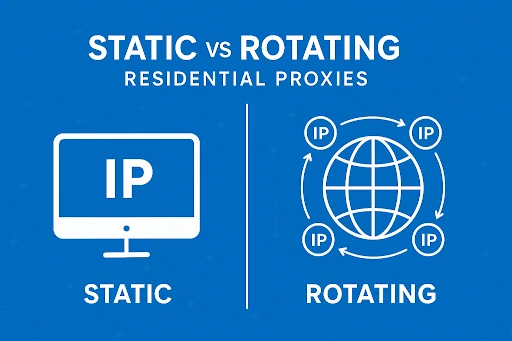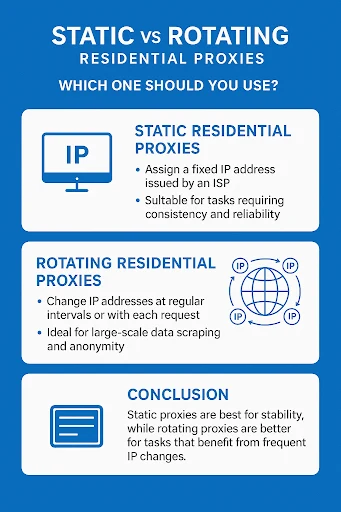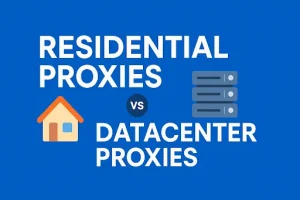
If you’ve ever used residential proxies for web scraping, SEO monitoring, or sneaker copping, you’ve probably noticed two main types: static residential proxies and rotating residential proxies.
While both mask your real IP address and give you a residential identity, the way they rotate, handle sessions, and suit specific use cases are quite different. In this article, we’ll break down their key differences, benefits, and help you decide which one fits your workflow best.
What Are Residential Proxies?
Residential proxies use real IP addresses provided by Internet Service Providers (ISPs), not data centers. These IPs are linked to actual physical devices, so when you connect through one, websites see you as a genuine user, not a bot.
In short:
✅ You get higher anonymity
✅ Lower risk of being blocked
✅ Perfect for accessing geo-targeted content
What Are Static Residential Proxies?
Static residential proxies (also called sticky or dedicated proxies) give you a fixed residential IP for a specific period — sometimes minutes, hours, or even days.
How They Work
When you connect, you’re assigned a single residential IP that doesn’t change unless you disconnect or manually rotate it.
Best For
- Logging into multiple social media or eCommerce accounts
- Managing ad campaigns
- Conducting SEO audits that need session persistence
- Verifying ads or scraping sites that block frequent IP changes
Pros
- Stable sessions
- Fewer connection interruptions
- Consistent IP reputation
Cons
- Easier to get blocked if overused
- Limited anonymity for long scraping sessions
What Are Rotating Residential Proxies?
Rotating residential proxies change your IP address automatically after each request or set time interval.
How They Work
Every time your connection refreshes, you’re assigned a new residential IP from the provider’s pool. This rotation makes it look like each request comes from a different real user.
Best For
- Large-scale web scraping or data collection
- Price comparison and SEO data monitoring
- Market research and competitor intelligence
- Avoiding IP bans and rate limits
Pros
- Virtually unblockable for data scraping
- High anonymity
- Continuous fresh IPs
Cons
- Sessions reset often — not ideal for logins
- Slower response times in some cases
Static vs Rotating Residential Proxies: Key Differences
Feature | Static Residential Proxies | Rotating Residential Proxies |
|---|---|---|
IP Consistency | Fixed | Changes automatically |
Anonymity Level | Medium | High |
Best Use Case | Account management, ad verification | Web scraping, data mining |
Risk of IP Ban | Higher | Very low |
Speed | Usually faster | Slightly slower |
Connection Stability | Strong | Depends on the rotation time |
Ease of Management | Simple | Requires rotation handling |
Which One Should You Use?
It depends on your use case:
- 👤 Choose Static Residential Proxies if you need stable sessions — for example, managing multiple social or ad accounts where the same IP is important.
- ⚙️ Choose Rotating Residential Proxies if your goal is data scraping, SEO monitoring, or bypassing anti-bot systems at scale.
For most data-heavy or automation workflows, rotating proxies offers better scalability and safety.

Pro Tip
Many premium providers (like Bright Data, decodo proxy, and Soax) let you control rotation frequency — meaning you can use sticky sessions for a few minutes while still enjoying IP rotation. That gives you the best of both worlds.
Conclusion
Both static and rotating residential proxies play vital roles in digital marketing, data scraping, and automation. If stability matters more — go static. If stealth and scalability matter more, go rotating.
The key is matching your proxy setup to your exact needs — and testing both types can help you find the perfect balance between performance and privacy.
Frequently Asked Questions
It depends on your needs. Rotating residential proxies are better for large-scale data scraping, SEO monitoring, and avoiding IP bans. Static residential proxies are better for stable logins, social media management, and ad verification.
Yes. Most proxy providers let you choose the proxy mode (static or rotating) in your dashboard. Some even offer hybrid options with adjustable rotation time.
Usually, yes — because each request uses a different IP, adding a bit of latency. But premium proxy networks minimize this delay using optimized residential IP pools.
Static residential proxies are safer for long, consistent sessions like account management. Rotating proxies may interrupt sessions when IPs change.



